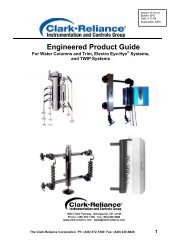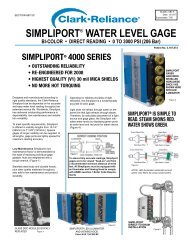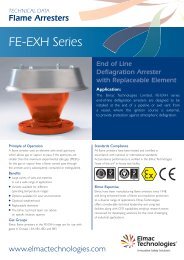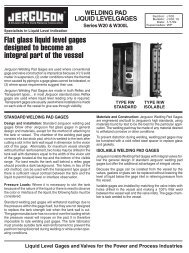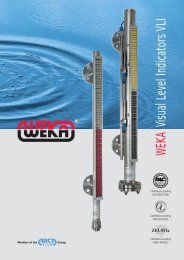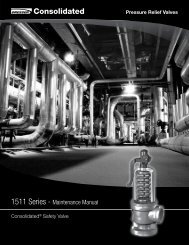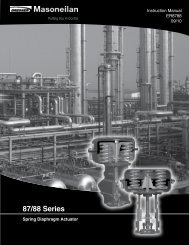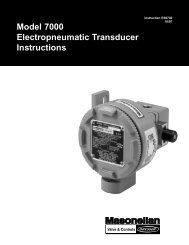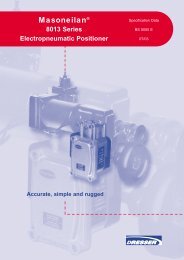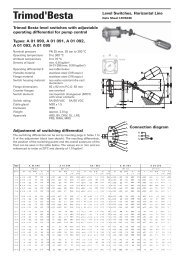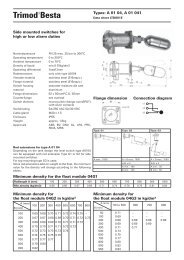1900 Series - Maintenance Manual
1900 Series - Maintenance Manual
1900 Series - Maintenance Manual
Create successful ePaper yourself
Turn your PDF publications into a flip-book with our unique Google optimized e-Paper software.
II. Terminology for Safety Relief Valves• Accumulation - the pressure increase over themaximum allowable working pressure of the vesselduring discharge through the SRV, expressed as apercentage of that pressure or in actual pressureunits.• Backpressure - the pressure on the discharge sideof the SRV:• Built-up Backpressure - the pressure thatdevelops at the valve outlet, after the SRV hasbeen opened, as a result of flow.• Superimposed Backpressure - the pressure inthe discharge header before the SRV is opened.• Constant Backpressure - the superimposedbackpressure that is constant with time.• Variable Backpressure - the superimposedbackpressure that varies with time.• Blowdown - the difference between set pressureand re-seating pressure of the SRV, expressed as apercentage of the set pressure or in actual pressureunits.• Cold Differential Set Pressure - the pressure atwhich the valve is adjusted to open on the teststand. This pressure includes the correctionsfor backpressure and/or temperature serviceconditions.• Differential Between Operating and Set PressuresValves in installed process services will generallygive best results if the operating pressure does notexceed 90% of the set pressure. However, on pumpand compressor discharge lines, the differentialrequired between the operating and set pressuresmay be greater because of pressure pulsationscoming from a reciprocating piston. The valveshould be set as far above the operating pressureas possible.• Lift - the actual travel of the disc away from theclosed position when a valve is relieving.• Maximum Allowable Working Pressure - themaximum gauge pressure permissible in a vesselat a designated temperature. A vessel may not beoperated above this pressure, or its equivalent, atany metal temperature other than that used in itsdesign. Consequently, for that metal temperature,it is the highest pressure at which the primarypressure SRV is set to open.• Operating Pressure - the gauge pressure towhich the vessel is normally subjected in service.A suitable margin is provided between operatingpressure and maximum allowable working pressure.For assured safe operation, the operating pressureshould be at least 10% under the maximumallowable working pressure or 5 psi (.34 bar),whichever is greater.• Overpressure - a pressure increase over theset pressure of the primary relieving device.Overpressure is similar to accumulation when therelieving device is set at the maximum allowableworking pressure of the vessel. Normally,overpressure is expressed as a percentage of setpressure.• Rated Capacity - the percentage of measured flowat an authorized percent overpressure permittedby the applicable code. Rated capacity is generallyexpressed in pounds per hour (lb/hr) for vapors,standard cubic feet per minute (SCFM) or m3/min for gases, and in gallons per minute (GPM) forliquids.• Relief Valve - an automatic pressure-relievingdevice, actuated by static pressure upstream fromthe valve. A relief valve is used primarily for liquidservice.• Safety Relief Valve (SRV) - an automatic pressurerelievingdevice used as either a safety or reliefvalve, depending upon application. The SRV is usedto protect personnel and equipment by preventingexcessive overpressure.• Safety Valve - an automatic pressure-relievingdevice actuated by the static pressure upstreamof the valve, and characterized by a rapid openingor “pop” action. It is used for steam, gas, or vaporservice.• Set Pressure - the gauge pressure at the valveinlet for which the relief valve has been adjustedto open under service conditions. In liquid service,the inlet pressure at which the valve starts todischarge determines set pressure. In gas or vaporservice, the inlet pressure at which the valve popsdetermines the set pressure.• Simmer - the audible passage of a gas or vaporacross the seating surfaces just before “pop.” Thedifference between this start-to-open pressureand the set pressure is called “simmer.” Simmeris generally expressed as a percentage of setpressure.<strong>1900</strong> <strong>Series</strong> Safety Valve (July/2010) | 7



